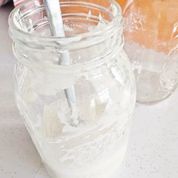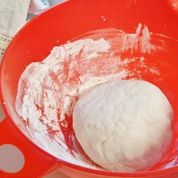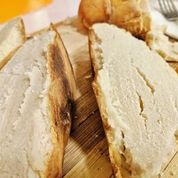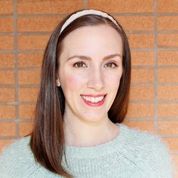A Sourdough Story
Note from Marlene: Please welcome my new friend Tara Besore. She and I were both inspired by Laura Ingalls Wilder to seek the simple life in our gardens and in our kitchen. Here’s her wonderfully honest account of the first time she attempted to make sourdough bread.
Seeking the Simple Life
It’s probably Laura Ingalls Wilder’s fault. Her stories of the simple life made me want to trade my suburban childhood for homestead living, getting by on self-reliance and fresh air. This ambition drew me to hobbies like crocheting, gardening, and more recently bread making.
For now I still reside in Portland’s periphery, where a quick charge of the Prius can always get you to a nearby Target. When my husband Eric and I went into quarantine, though, it was time to put my DIY skills to use. Armed with a 25-pound bag of Costco flour, I was determined to find out how well I could keep us alive and fed without depending on the conveniences of the city.
There were some early successes.
Putting My DIY Skills to Use
Half a bag of chocolate chips became tasty muffins. Our last two eggs turned into a special crepe breakfast. Then for my grandma’s birthday, strawberry yogurt sweetened a batch of cupcakes that Eric and I delivered in a contact-free porch drop after dark.
But as the days passed there was one thing I really missed: fresh bread. And I wasn’t the only one. Grocery stores across the nation sold out of yeast as quickly as toilet paper. You couldn’t even get it on Amazon.
If I wanted to make bread with my surplus of flour, I would have to find my own way to leaven it. So I turned to my Little House Cookbook, which I remembered had a recipe for sourdough starter and bread like Ma Ingalls made.
Making the Sourdough Starter
The recipe seemed foolproof. All you need is flour, water, and time to infuse a sourdough starter with yeast and bacteria from the air, allowing you to make puffed up bread.
There was a warning in the bread recipe that gave me pause. “Do not expect perfection on the first try. Make notes and make adjustments, one at a time.” But why wouldn’t it work out? Follow the recipe, get the bread.
The first step was easy. All I had to do was leave the flour uncovered in a shallow pan for two to three days, exposing it to microbes in the air. (Hungry yet?) I waited the full three days to ensure microbe infiltration.
The next step required mixing the flour with warm water in a jar, and keeping it between 70 and 90 degrees Fahrenheit for two days. This was tricky. Our drafty house prefers temps in the 60s most of the year.
I thought about storing my science experiment in the boiler room. As long as the heater’s running, the small basement room stays toasty. But it was springtime, and I found the boiler room was dormant and cold.
The next warmest room is usually the home office, where the computers do most of the heating work. I set the office thermostat to 75 degrees to make sure it was warm enough. The yeast was comfortable, but Eric and I weren’t, as temperatures kept creeping into the high 70s. We both work from home, by the way, so there was no escape.
That night, the heat leaked into multiple rooms, not just the office. Neither of us slept well in the yeasty, humid air.
“How long do we have to do this?” Eric asked.
I told him it was just for a couple more days, and it would be worth it. The resulting bread had to make up for the inflated heating bill coming our way.
Walking into the office that morning, I could see the little yeast bubbles starting to appear. I texted my mom-in-law, “Bubbles forming in the sourdough/yeast starter…it’s working!”
Eric joked that we should kill it with fire.
We both wondered, how is it okay to store food in the “danger zone” temperature range for days at a time, create a haven of bacteria, and then eat it? Everything about sourdough starter seems to violate food handling rules. But apparently all the bacteria dies off as the bread bakes, and the bottom line is it’s delicious.
By day six, the starter had more than doubled in size, nearly filling the jar that I originally thought was too big. It was a proper sourdough starter, just like the one in the Ingalls kitchen. I don’t know where things veered off course.
It was time to double the starter by discarding half and feeding the remainder with more flour and water. Just one more stuffy, sleepless night, and then it was finally cooking time.
Baking Sourdough Bread from Starter
I woke up that Saturday morning with the promise of hot sourdough bread at the top of my mind. It would pair perfectly with the batch of spaghetti I was planning for dinner. I only had six more hours of bread-making efforts standing between me and an evening of homemade comfort food—the trappings of the simple life.
The sourdough recipe called for bread flour, warm water, salt, and the starter, mixed together with 10 minutes of kneading. I fully committed to all 10 minutes, even as my shaky suburban biceps were screaming at me. Lackluster kneading would not threaten my success.
Next, I put the dough in a warm place to rise, waiting for it to double in size. I checked it after one hour, two hours, three hours. No change.
After five hours, it was supposed to be baking time. The bread still hadn’t risen. Apprehensive but refusing to accept defeat, I thought to myself, “Let’s throw it in the oven and see what happens.”
When the timer buzzed an hour later, I retrieved the world’s densest bread. If there were any air bubbles, you would have needed a microscope to find them. The hardened loaf seemed better suited as a self-defense weapon than an appetizer.
But spaghetti night must go on. I smothered my creation in marinara to make it borderline palatable. It was loosely reminiscent of eating real bread in the pre-quarantine days. Just with less flavor and more jaw pain.
Eric tried to convince me this was the way simple pioneer food was supposed to taste. “They spent all day working hard in the fields. By the time they had dinner they were so worn out that any food tasted amazing,” he said.
“So Laura Ingalls was lying to me this whole time?” I asked, doubtful. Her books describe food sent from the heavens: biscuits with creamy brown gravy, golden buckwheat cakes with brown-sugar syrup, and doughnuts fresh out of the frying pan. Eric’s attempt to cheer me up was appreciated, but I knew Ma Ingalls had to be a better cook than this.
I retraced my steps and tried to figure out where I failed. A Google search revealed common bread-making mishaps. I might have over-kneaded the dough, a likely possibility as I was aggressive in my attempt to succeed. I might have used overly warm water, killing the yeast when I first mixed the dough. Or it could have been Oregon’s fault. My mom-in-law said she always had a hard time getting bread to rise in the rainy Pacific Northwest.
Whatever the reason for my failure, I remembered Laura never claimed that life on the prairie was easy. She described a life full of challenges, surprises, and hard work.
I put in the effort and things didn’t turn out as planned, but my bread was good enough to keep us alive for another day in quarantine. No, I didn’t achieve “perfection on the first try,” as the recipe had warned. I did, however, get a taste of the simple life.
About
Tara Besore is the creator of Hammer & a Headband, a home and garden blog full of DIY guides and inspiration. She keeps busy restoring her 1960s house, taming her yard, and documenting the process on her blog. Thankfully, Tara is better at home improvement than bread making. Her goal is to help people design happy, beautiful homes. She lives in Portland with three of her favorite people, two of whom are cats. She can be found at https://www.hammerandaheadband.com/.
Share this post





Marlene, thanks for sharing my guest post. It’s always nice to connect with another Little House fan, and I’m so inspired by your story of living off the land, with ducks, chickens and milking goats! I think I’ll give bread making another try when the weather warms up this summer…at least I can increase my odds of success!
Love this description of your bread making attempts! I have never made bread, but have bought sourdough at my local market- prior to Covid-19 lockdown. Here, where I live in Burleigh on the Gold Coast in Queensland, Australia, restrictions have eased. We can walk on the beach, visit National Parks and from this weekend, local Farmers’ Markets are ‘re opening. Social distancing of 1.5 metres of course is mandatory.